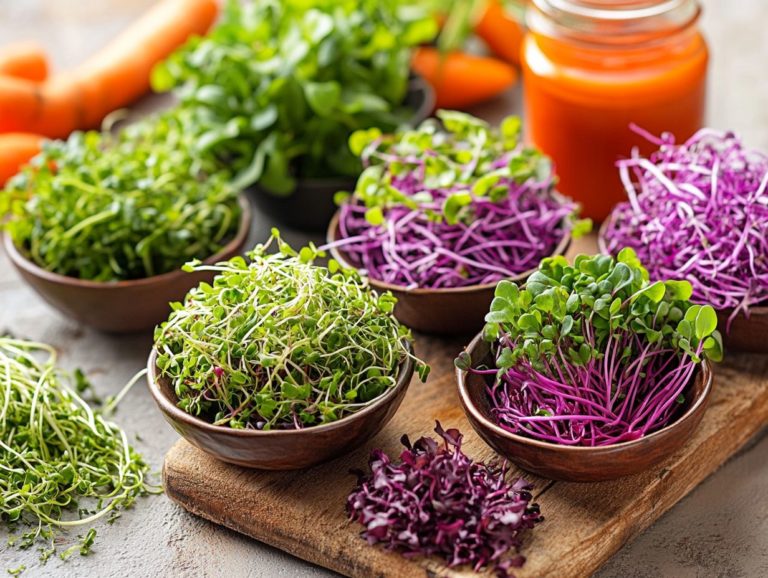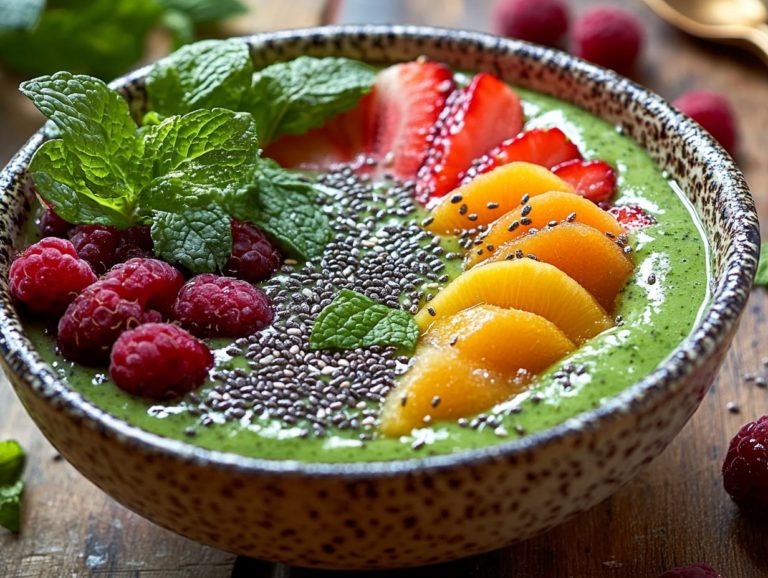68. Cooking with Microgreens: Flavor and Nutrition
Microgreens are tiny, vibrant plants that deliver a remarkable burst of flavor and nutrition. They have become a staple in the culinary world.
Explore what sets these miniature greens apart, from their distinctive taste profiles to their impressive nutrient content.
Discover how to creatively incorporate microgreens into your meals. Utilize various cooking methods and try enticing recipes at home.
You’ll find essential tips for growing and storing these culinary gems. This ensures you can savor their benefits throughout the year.
Get ready to transform your meals with the incredible flavors of microgreens!
Contents
Key Takeaways:
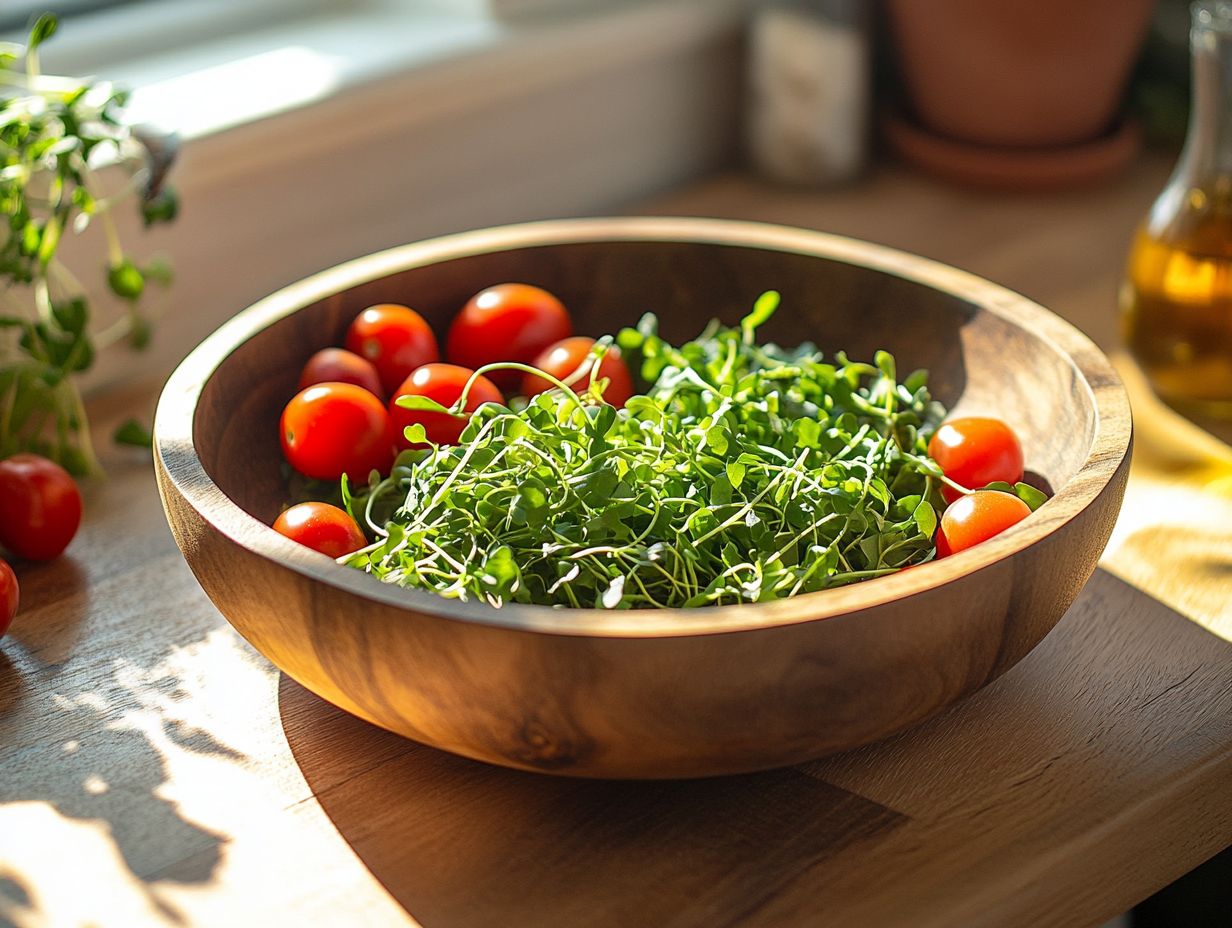
- Microgreens add unique and intense flavors to dishes, making them a versatile and delicious ingredient in cooking.
- Despite their small size, microgreens are packed with nutrients, making them a great addition to a healthy diet.
- Growing and storing microgreens is easy and can be done at home, giving you a constant supply of fresh, nutrient-dense greens that support health benefits.
What are Microgreens?
Microgreens are young edible plants, harvested just after their first true leaves emerge. They add a vibrant touch to the culinary landscape with their diverse flavors and colors.
Typically grown from sprouted seeds, these little nutrients are rich foods. Their rising popularity among chefs and health enthusiasts is well-deserved.
With an impressive variety of species available, these tiny greens boast an array of health benefits. They enhance the aesthetic of your dishes and elevate their nutritional value, providing a delicious way to nourish your body.
Definition and Characteristics
Microgreens are the young seedlings of edible vegetables, herbs, or other plants, harvested at an early stage typically within 7 to 21 days after germination. This contributes to their impressive nutrient retention.
These vibrant greens come in many colors. You can find bold purples, like amaranth, and delicate greens, like basil. Each offers unique visual appeal that can elevate any dish you create.
Beyond their striking appearances, microgreens pack an intense flavor punch, ranging from subtly sweet to boldly peppery. They often contain concentrated levels of vitamins and minerals, making them a favored choice for those who prioritize health and culinary excellence.
By incorporating these nutrient-dense greens into your salads, sandwiches, or as garnishes, you can significantly enhance both the appearance and health benefits of your meals.
Flavor Profile of Microgreens
The flavor profile of microgreens is impressively diverse. They present a rich tapestry of tastes that can elevate any dish, from simple salads to gourmet entrees.
Each variety, whether you prefer the peppery kick of arugula or the sweet notes of basil, brings unique flavors to the table. These microgreens not only enhance your dishes, but they also offer health-promoting benefits, highlighting their essential role in modern cooking.
Taste and Aroma Differences from Mature Greens
Microgreens offer a more intense flavor and distinct aroma than their mature counterparts. They present nuanced tastes and functional foods that can elevate both simple and intricate dishes.
Consider this: while mature arugula will give you that bold peppery kick, young arugula microgreens provide a milder yet zestier profile. This can truly brighten up your salads and enhance your sandwiches.
Similarly, the sweetness of mature beets finds harmony with the earthy undertones of beet microgreens. They make an excellent choice for garnishing gourmet entrees or adding depth to your grain bowls.
You can creatively incorporate these tiny greens across various culinary applications from vibrant toppings on delicate canap s to stunning inclusions in soups and sauces. They elevate the flavor and add a visually striking touch to any dish you craft.
Start experimenting with microgreens today and discover your favorite flavors!
Nutritional Benefits of Microgreens
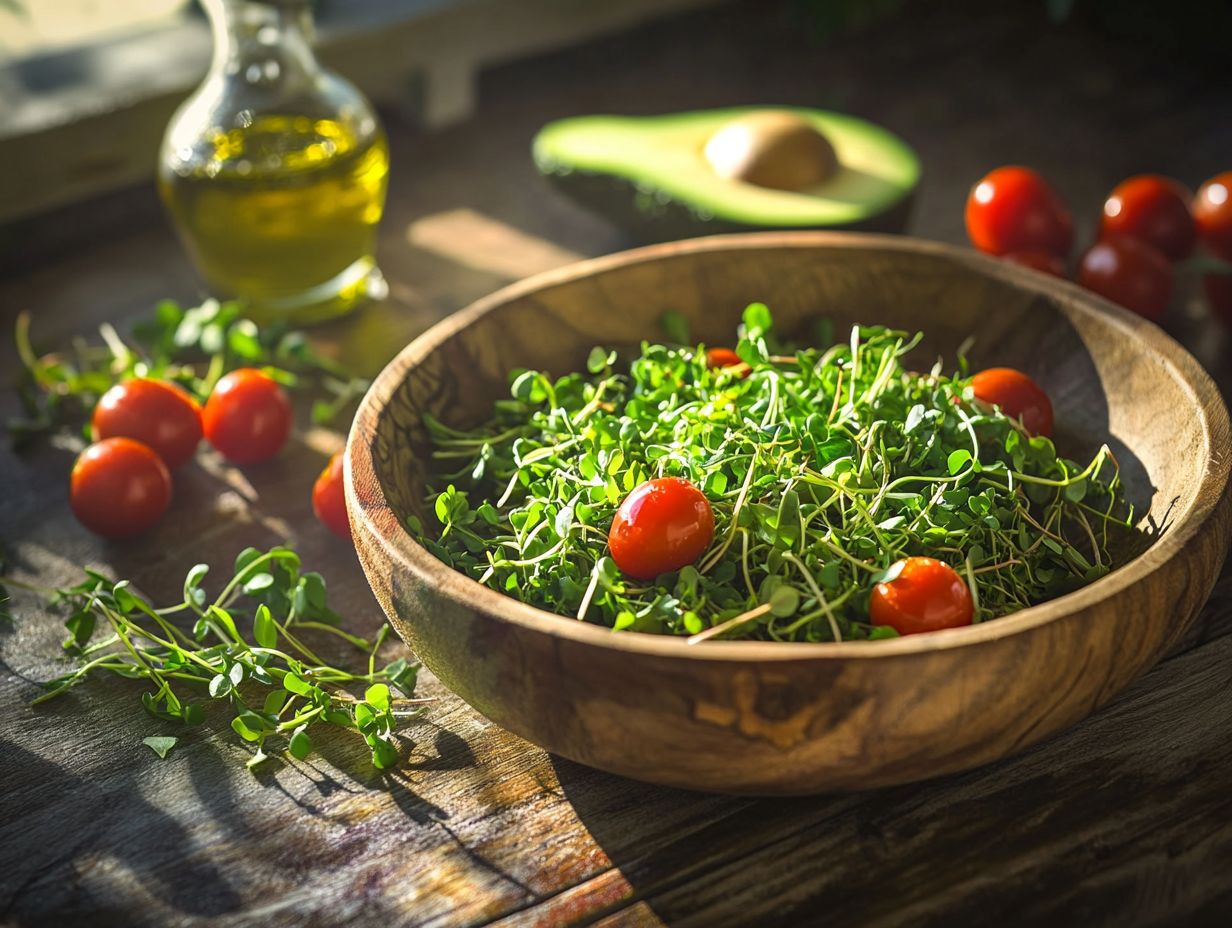
The nutritional benefits of microgreens are truly remarkable. They often boast higher concentrations of vitamins, minerals, and antioxidants compared to mature greens.
This makes them an essential ally in the fight against malnutrition and chronic diseases.
Incorporating microgreens into your diet is not just a flavorful choice; it s a powerful way to pack a wealth of nutrients, including ascorbic acid and -carotene, into every bite.
Comparing Nutrient Content with Mature Greens
When you compare the nutrient content of microgreens to that of mature greens, research shows that microgreens can pack a nutritional boost, boasting up to six times more nutrients, including vital vitamins and minerals essential for your health.
The biggest differences appear in the concentrations of vitamin C and -carotene. For example, some microgreens can contain more vitamin C than their fully grown counterparts, making them a powerful ally in bolstering your immune system.
Similarly, -carotene, which is a precursor to vitamin A, plays a crucial role in maintaining both vision and skin health.
The health-enhancing qualities of these tiny greens are due to their superior nutrient retention and natural substances that benefit your health. Incorporating them into your diet regularly can significantly boost your overall well-being and contribute to a balanced lifestyle.
How to Cook with Microgreens
Cooking with microgreens unlocks a world of culinary possibilities. These delightful little greens can be effortlessly woven into many dishes.
They add both flavor and nutritional benefits without the need for intricate cooking techniques.
Their delicate nature makes them perfect for use as garnishes or for blending into salads, soups, and smoothies, showcasing their appeal in food establishments and establishing them as a versatile ingredient in kitchens across the globe.
Incorporating Microgreens into Meals
Incorporating microgreens into your meals can truly elevate the flavor and nutritional profile of any dish. You can use them as a garnish, filling, or even the main ingredient.
Imagine topping a vibrant quinoa salad with a mix of radish and sunflower microgreens. Not only does this enhance the visual appeal, but it also adds a delightful zesty crunch that can make your taste buds dance!
Similarly, think about tossing in some pea shoots into a stir-fry with tofu or chicken. They provide a fresh burst of flavor while maintaining the dish’s nutritional integrity talk about a win-win!
To preserve their delicate taste and nutrients, consider adding microgreens at the end of cooking or using them in raw applications. Why not throw them into a refreshing smoothie? You ll love the burst of flavor!
These versatile greens can effortlessly adapt to various cooking methods, enriching both simple and elaborate meals. For inspiration, check out cooking with microgreen varieties: tips and tricks to transform your culinary creations into something truly exceptional.
Recipes Featuring Microgreens
Recipes featuring microgreens present you with an extraordinary opportunity to delve into their distinct flavors and remarkable health benefits. This encourages both seasoned chefs and home cooks alike to experiment with these nutrient-dense additions in their culinary creations.
From vibrant salads that pop with color to rich, flavorful soups, the possibilities in your kitchen are truly endless when you incorporate microgreen varieties into your dishes.
Delicious and Nutritious Dishes to Try
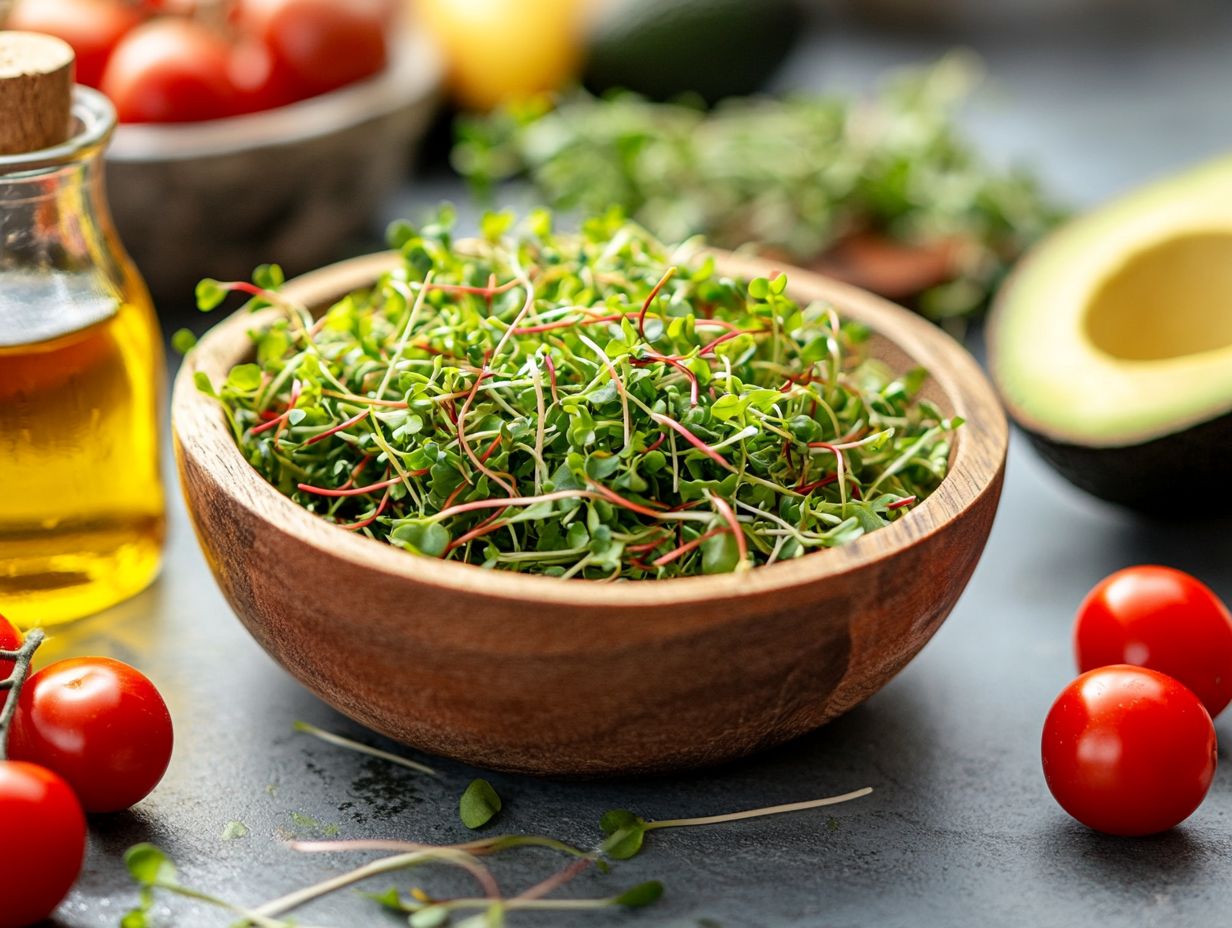
Explore a selection of delicious and nutritious dishes that seamlessly incorporate microgreens, showcasing their remarkable ability to elevate flavor. These dishes also deliver a health boost.
Imagine vibrant salads bursting with freshness. Or hearty main courses radiating warmth; each recipe highlights the incredible versatility of microgreens. Whether you experience the peppery kick of arugula microgreens in a zesty starter or the subtle sweetness of radish greens artfully placed atop a grilled fish fillet, every dish presents a unique twist that tantalizes the palate. Discover ways to enhance flavor in microgreens to elevate your culinary creations.
With a focus on wholesome and accessible ingredients, your cooking methods can range from simple sautés to elegant presentations. Incorporating these tiny greens allows you to enjoy a wealth of vitamins and antioxidants, ensuring that your meals deliver both exquisite taste and nourishing benefits. For a deeper understanding, check out our microgreen varieties: taste and flavor guide.
Growing and Storing Microgreens
Get ready to spice up your meals! Growing and storing microgreens is an enriching pursuit that grants you the pleasure of accessing fresh greens right from your kitchen.
With a few straightforward techniques and insightful tips for successful cultivation and preservation, you can savor the health benefits of microgreens all year round. This makes them a great choice to find in supermarkets.
Tips for Successful Cultivation and Preservation
For successful cultivation and preservation of microgreens, focus on a few essential tips: selecting the right seeds, providing adequate light, and maintaining the right amount of water.
These young plants flourish when placed in a sunny spot or beneath grow lights that offer bright, indirect light for about 12 to 16 hours each day. Proper watering is equally important; aim to keep the soil damp but not soggy to encourage healthy root development while avoiding the dreaded mold.
Regarding storage, keeping your microgreens in a sealed container in the refrigerator is key to preserving their freshness and nutrient content. To enhance their longevity, consider using a paper towel to absorb any excess moisture, ensuring those vibrant greens remain crisp and nourishing for as long as possible.
Frequently Asked Questions
1. What are microgreens and why are they popular in cooking?
Microgreens are young, tender plants harvested when they are only a few inches tall. They are packed with nutrients and have a concentrated flavor, making them a popular addition to dishes in the culinary world.
2. How do microgreens add flavor to dishes?
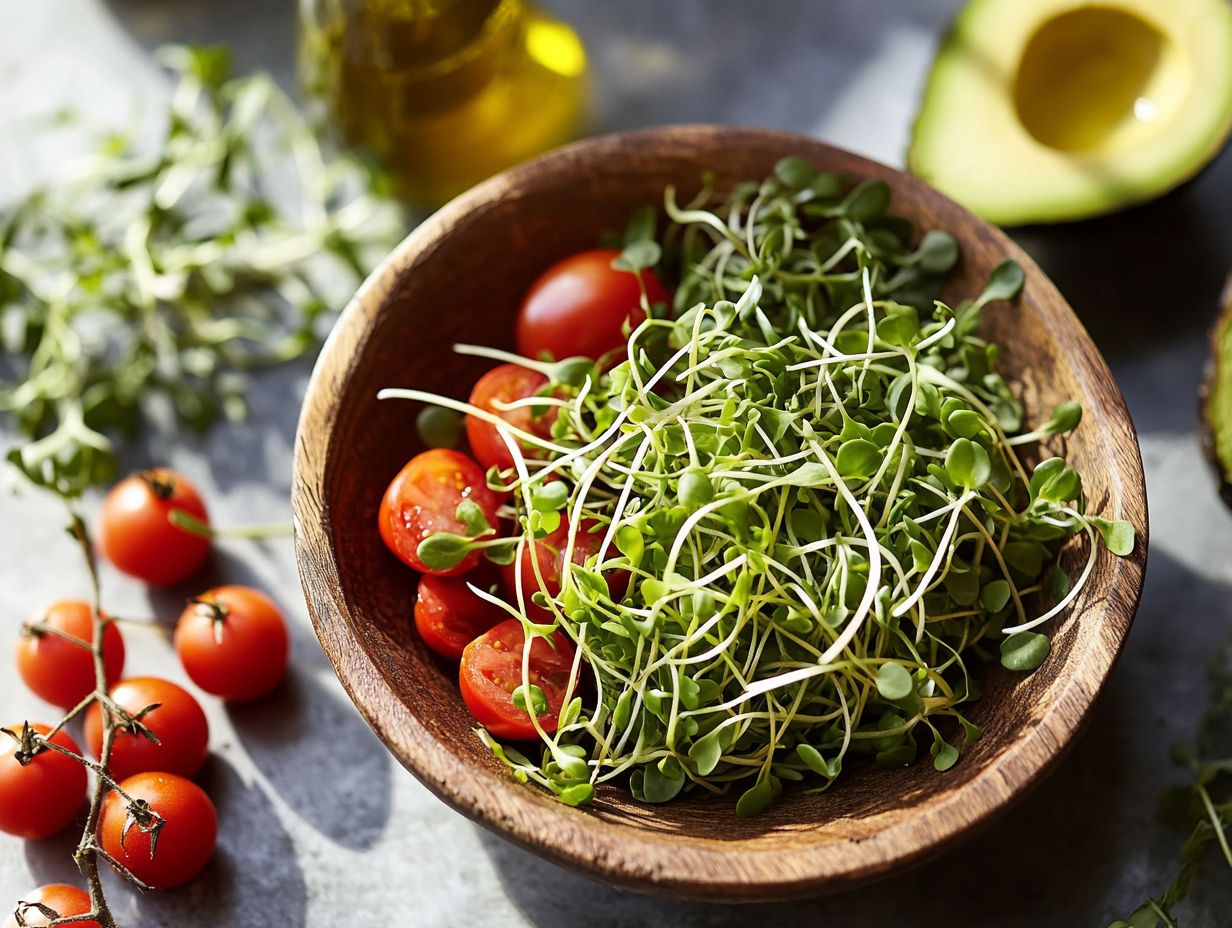
Microgreens come in various flavors, such as spicy, nutty, and earthy. They can be used as a garnish or incorporated into dishes for added texture and flavor. Their intense flavor can elevate any dish, making it more visually appealing and delicious.
3. Are microgreens nutritious?
Yes, microgreens are highly nutritious as they contain a higher concentration of vitamins, minerals, and antioxidants compared to their mature counterparts. They are also rich in protein and fiber, making them a great addition to a healthy diet.
4. How can I incorporate microgreens into my cooking?
Microgreens can be used in various ways, such as topping salads, sandwiches, and soups. They can also be blended into smoothies or added to stir-fries for an extra nutritional boost. Get creative and experiment with different dishes to find your favorite way to use microgreens.
5. Can I grow microgreens at home?
Yes, microgreens can easily be grown at home with minimal equipment and space. You can use a shallow tray, some soil, and seeds to grow your microgreens in just a few weeks. This is a great way to have a fresh supply of microgreens on hand for your cooking needs.
6. Are there any precautions I should take when cooking with microgreens?
It’s crucial to wash microgreens thoroughly before cooking. This helps ensure they are clean and safe to eat.
Use them within a few days of harvesting for the best taste and health benefits. If you have allergies or medical conditions, talk to your doctor before eating microgreens.

